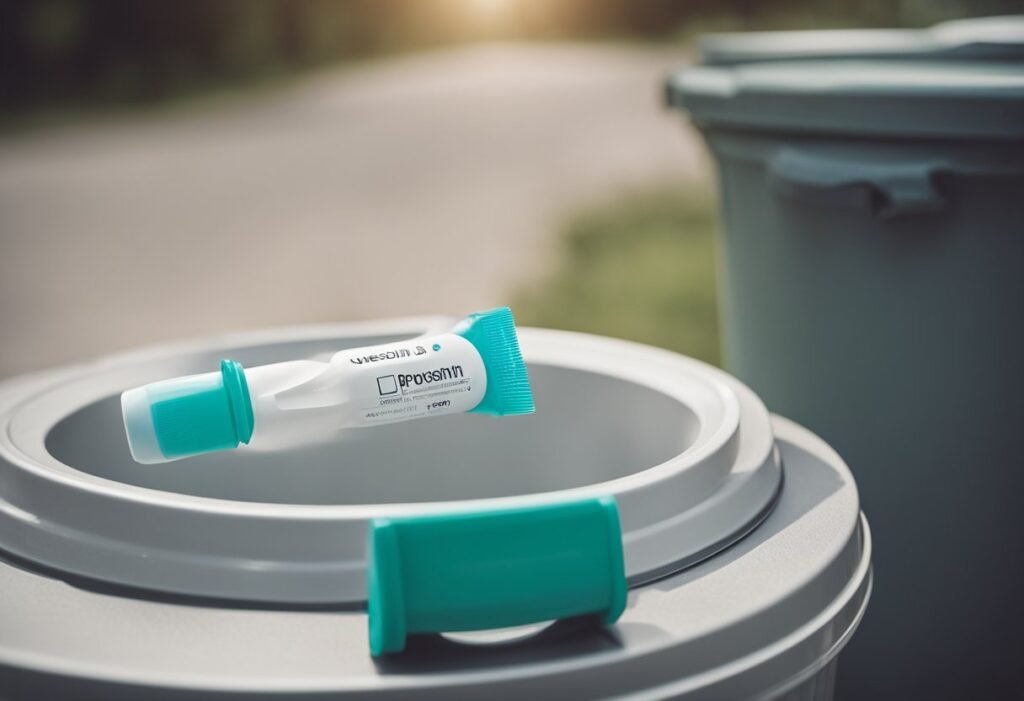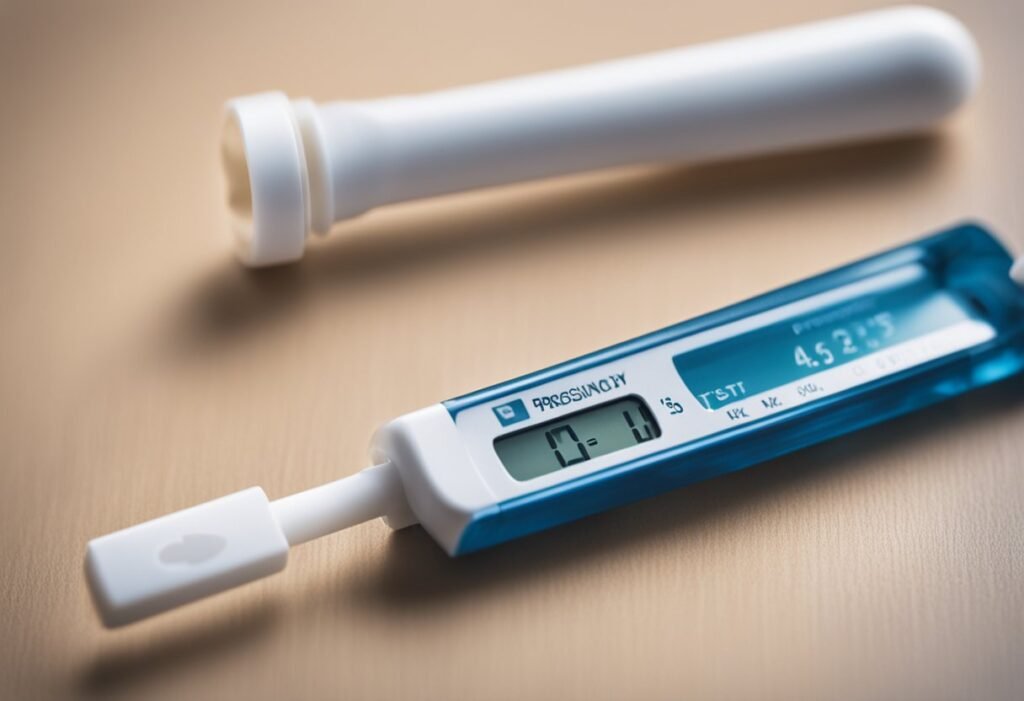In today’s fast-paced world, where budgeting and frugality are often necessary, individuals may wonder about the reusability of products, including medical items like pregnancy tests.
So the question raised in the mind that “Can you reuse a pregnancy test”?
So the answer to this is no you can’t reuse a pregnancy test again.
While it may seem like a cost-effective option to reuse a pregnancy test, understanding how these tests function is crucial before considering their reuse. Pregnancy tests are designed to detect the hormone hCG in urine, and once they are used, the chemical composition is altered, which can lead to unreliable results.

Table of Contents
Reuse of pregnancy tests is a topic that garners attention, especially from those who are eager to determine pregnancy status without buying multiple kits. However, a single-use design is inherent to home pregnancy tests, as they are meant for a one-time accurate measurement. It’s important to consider the scientific and health perspectives when discussing the reliability and safety of reusing these tests.
Key Takeaways
- Reusing pregnancy tests can lead to false or misleading results due to the alteration of the chemical components.
- Home pregnancy tests are scientifically designed for single use only to ensure accuracy.
- For reliable results, individuals should use a new test as directed and consult with healthcare professionals for confirmation.
Understanding Pregnancy Tests

Pregnancy tests are a key tool I use to determine if I am expecting. The tests work by detecting the presence of human chorionic gonadotropin (hCG), a hormone produced during pregnancy. Let’s take a more detailed look at the components of these tests and their functionality.
Components and Functionality
Pregnancy tests, particularly home pregnancy tests, consist of a few critical components. The main part is the test strip, which contains special chemicals that react with the hCG hormone in my urine. When I use a test, I typically either urinate directly onto the test strip or dip the strip into a container of my urine. The tests have control and test lines: the control line appears to show the test is working, while the test line only appears if hCG is detected.
Chemical Reaction: This test strip includes antibodies coated with enzymes that bind to hCG, if present. When they come into contact with hCG, a chemical reaction occurs, causing a visible line to form, which indicates a positive result. This reaction is designed to be extremely sensitive to ensure accuracy.
Hormone Levels and Detection
Hormone Detection: Pregnancy tests are precisely calibrated to identify a certain level of hCG in the urine. Usually, hCG can be detected shortly after a fertilized egg attaches to the uterus, typically 6-12 days after conception. The levels of hCG in my body increase rapidly every day in early pregnancy, which is why a test might show a negative result if I take it too early, even if I am pregnant.
Sensitivity of Test Kits: Not all test kits are created equally; some can detect lower levels of hCG and can be used earlier than others. It’s important that I follow the manufacturer’s instructions closely for the most reliable results.
Evaporation Line: Sometimes, a faint line may appear after the allotted test time, known as an evaporation line. This line can create confusion but it does not indicate pregnancy; it’s simply a result of the urine evaporating from the test strip.
By understanding these two essential aspects of pregnancy tests, I empower myself with the knowledge to accurately interpret the results they provide.
Factors Affecting Test Accuracy

When I rely on a pregnancy test, understanding the variables that impact its accuracy is crucial. These factors can lead to false negatives or false positives.
Proper Usage and Instructions
To ensure the accuracy of a pregnancy test, it’s essential that I follow the instructions carefully. I should perform the test using the first urine of the day, as it typically contains the highest concentration of the pregnancy hormone hCG. Moreover, incorrect usage such as not waiting the recommended time before reading the result or misinterpreting evaporation lines as a positive result may lead to inaccurate outcomes.
Impact of External Factors
Several external factors can affect the pregnancy test’s accuracy. For instance, some medications, particularly those containing hCG or its analogues, can lead to a false positive. Furthermore, using a test past its expiration date may yield unreliable results, as the reactive agents degrade over time. Whether the test has been stored at the correct temperature and humidity levels also plays a part, since exposure to adverse elements can compromise the test’s integrity.
Risks of Reusing Pregnancy Tests

When examining the risks of reusing pregnancy tests, I consider both the reliability of the test and the subsequent impact on emotional well-being. These devices are designed for one-time use, ensuring accuracy during a highly sensitive period.
Can you reuse a pregnancy test? Why Tests Are Not Reusable
Pregnancy tests function by detecting the presence of the hormone hCG in urine. Once used, the reactive agents on the test strip are no longer active, rendering any attempt to reuse the test invalid. This holds for both standard and digital tests. With a digital test, the battery might also run out, or the digital display could malfunction upon reuse. Even if reusing a test seems economical, it’s not advisable – a pregnancy kit is a single-use instrument, primarily to avoid the risk of incorrect results that might come from reuse.
Potential Misinterpretations
Misinterpretation is a significant concern when reusing pregnancy tests:
- A false negative result may arise if the reagents are depleted, leading one to wrongly assume that they are not pregnant.
- Conversely, false positives might occur, especially if evaporation lines are mistaken for a positive result.
In essence, trying to reuse a test to save money can lead to more expenses if it results in the need for additional tests or an unnecessary doctor’s visit. The emotional toll of a false negative or false positive can also be heavy, making it advisable to use a new test each time.
Pregnancy tests are a critical component for early pregnancy detection, and I understand the temptation to reuse a test, especially given that they can be expensive. However, my knowledge confirms that the risks far outweigh any potential savings, presenting a clear case for using new tests for each attempt to ensure the most accurate results.
Alternatives and Recommendations
When considering the use of a pregnancy test, it’s important to recognize that once used, a test should not be reused. For those tracking a potential pregnancy, alternatives to reusing tests exist, providing accurate and reliable results.
When to Choose Digital or Standard Tests
Digital pregnancy tests: I recommend these for those who want clear, unambiguous results. Digital tests typically display the words “pregnant” or “not pregnant,” which is helpful if you have difficulty interpreting standard test lines. Digital options can be more expensive but are valuable for their ease of use, especially if you are new to testing for pregnancy.
Standard tests (HPTs or POAS): These are less costly and can be a practical choice for anyone trying to conceive (TTC) who may be testing frequently. Standard tests indicate pregnancy by showing one or more coloured lines to suggest the presence of the pregnancy hormone. However, it’s crucial to follow the test instructions precisely to avoid false negatives, which can occur with an expired pregnancy test or one with lower sensitivity.
Guidelines for Test Selection
- Sensitivity: Choose a test based on its sensitivity to hCG, the pregnancy hormone, particularly if testing before a missed period. The higher the sensitivity, the earlier a test can detect a fertilized egg in the uterus.
- Symptoms of pregnancy: If you’re experiencing symptoms, a home pregnancy test kit can offer initial insight, but I advise following up with a lab test for confirmation, especially if your menstrual cycles are irregular.
- Fertility journey: If you are on a fertility journey and concerned about costs, purchasing tests in bulk from a drugstore can be economical. However, make sure they are not close to the expiration date to avoid the risk of incorrect results.
- Confirming results: Whether you receive a positive or negative result, I recommend confirming the outcome with a blood test. This can provide definitive evidence of pregnancy and rule out any variables that might affect the accuracy of home tests, such as diluted urine or irregular menstrual cycles.
Conclusion
In choosing the right test for your needs, consider these factors to ensure you receive the most accurate information for your pregnancy journey. Remember, for any uncertainties or ongoing symptoms of pregnancy without positive test confirmation, consult with a healthcare provider to get reliable guidance based on your individual situation.
Frequently Asked Questions
In this section, I cover some of the most common inquiries regarding the reuse of pregnancy tests. It’s important to understand how these tests work and why they are intended for single use only.
Is it possible to use a pregnancy test more than once?
No, pregnancy tests are designed for a single use. Once the chemicals on the test strip react with human chorionic gonadotropin (hCG), they can’t be used again to provide reliable results. Home Pregnancy Tests (HPTs) detect hCG through a specific chemical reaction that occurs only once.
Does a negative result mean a pregnancy test can be reused?
Even if a pregnancy test shows a negative result, it cannot be reused. The reactive chemicals have already been exposed to urine and will not work accurately a second time. This includes tests where you might think there wasn’t enough urine applied at first.
What happens if a pregnancy test is used with an insufficient amount of urine?
Using insufficient urine on a pregnancy test can lead to inaccurate results. However, adding more urine won’t reactivate the test; the result remains invalid because the chemicals are designed for a one-time reaction.
Has anyone ever retested with a previously used negative pregnancy test?
There might be anecdotal reports of people retesting with a used negative pregnancy test, but any new results from such a test would be unreliable. The test’s accuracy cannot be trusted after it has been used.
What are the implications of peeing on a pregnancy test multiple times?
If you pee on a pregnancy test multiple times, you are likely introducing more factors that could cause incorrect readings. The test is not designed to be accurate after the first use, and any subsequent use would render the test invalid.
Are there pregnancy tests designed to be used more than once?
Currently, all pregnancy tests in the market are intended for one-time use only. They cannot be reused because the chemical compounds are active for a single reaction and cannot provide accurate results a second time.



